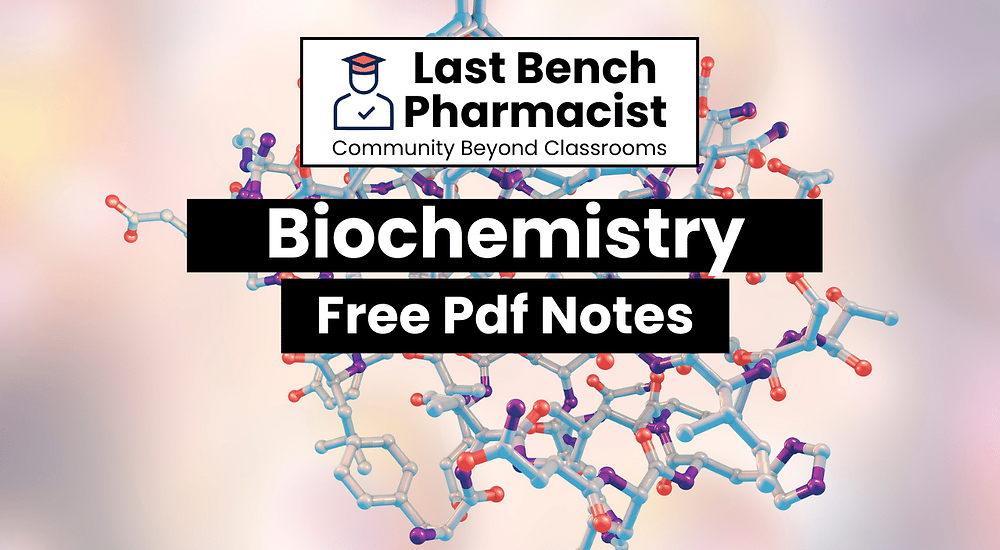



#bpharmnotes #bpharmpdfnotes #bpharmbiochemistrynotes
Conquering B.Pharm Biochemistry can feel like navigating a labyrinth of complex pathways and intricate molecules. But fear not, future pharmacists! This blog is your magic map, guiding you towards free B Pharm Biochemistry notes and equipping you with insider tips to unlock the secrets of metabolism with confidence.
Scope: Biochemistry deals with complete understanding of the molecular levels of the chemical process associated with living cells. The scope of the subject is providing biochemical facts and the principles to understand metabolism of nutrient molecules in physiological and pathological conditions. It is also emphasizing on genetic organization of mammalian genome and hetero & autocatalytic functions of DNA.
Objectives: Upon completion of course student shell able to
Understand the catalytic role of enzymes, importance of enzyme inhibitors in design of new drugs, therapeutic and diagnostic applications of enzymes.
Understand the metabolism of nutrient molecules in physiological and pathological conditions.
Understand the genetic organization of mammalian genome and functions of DNA in the synthesis of RNAs and proteins.
Introduction, classification, chemical nature and biological role of carbohydrate, lipids, nucleic acids, amino acids and proteins.
Concept of free energy, endergonic and exergonic reaction, Relationship between free energy, enthalpy and entropy; Redox potential.
Energy rich compounds; classification; biological significances of ATP and cyclic AMP
Glycolysis – Pathway, energetics and significance Citric acid cycle- Pathway, energetics and significance HMP shunt and its significance; Glucose-6-Phosphate dehydrogenase (G6PD) deficiency Glycogen metabolism Pathways and glycogen storage diseases (GSD) Gluconeogenesis- Pathway and its significance Hormonal regulation of blood glucose level and Diabetes mellitus
Electron transport chain (ETC) and its mechanism. Oxidative phosphorylation & its mechanism and substrate phosphorylation Inhibitors ETC and oxidative phosphorylation/Uncouplers
β-Oxidation of saturated fatty acid (Palmitic acid),Formation and utilization of ketone bodies; ketoacidosis De novo synthesis of fatty acids (Palmitic acid) Biological significance of cholesterol and conversion of cholesterol into bile acids, steroid hormone and vitamin D Disorders of lipid metabolism: Hypercholesterolemia, atherosclerosis, fatty liver and obesity
General reactions of amino acid metabolism: Transamination, deamination & decarboxylation, urea cycle and its disorders Catabolism of phenylalanine and tyrosine and their metabolic disorders (Phenyketonuria, Albinism, alkeptonuria, tyrosinemia) Synthesis and significance of biological substances; 5-HT, melatonin, dopamine, noradrenaline, adrenaline Catabolism of heme; hyperbilirubinemia and jaundice
Biosynthesis of purine and pyrimidine nucleotides Catabolism of purine nucleotides and Hyperuricemia and Gout disease Organization of mammalian genome Structure of DNA and RNA and their functions DNA replication (semi conservative model) Transcription or RNA synthesis Genetic code, Translation or Protein synthesis and inhibitors
Introduction, properties, nomenclature and IUB classification of enzymes Enzyme kinetics (Michaelis plot, Line Weaver Burke plot) Enzyme inhibitors with examples Regulation of enzymes: enzyme induction and repression, allosteric enzymes regulation Therapeutic and diagnostic applications of enzymes and isoenzymes Coenzymes –Structure and biochemical functions